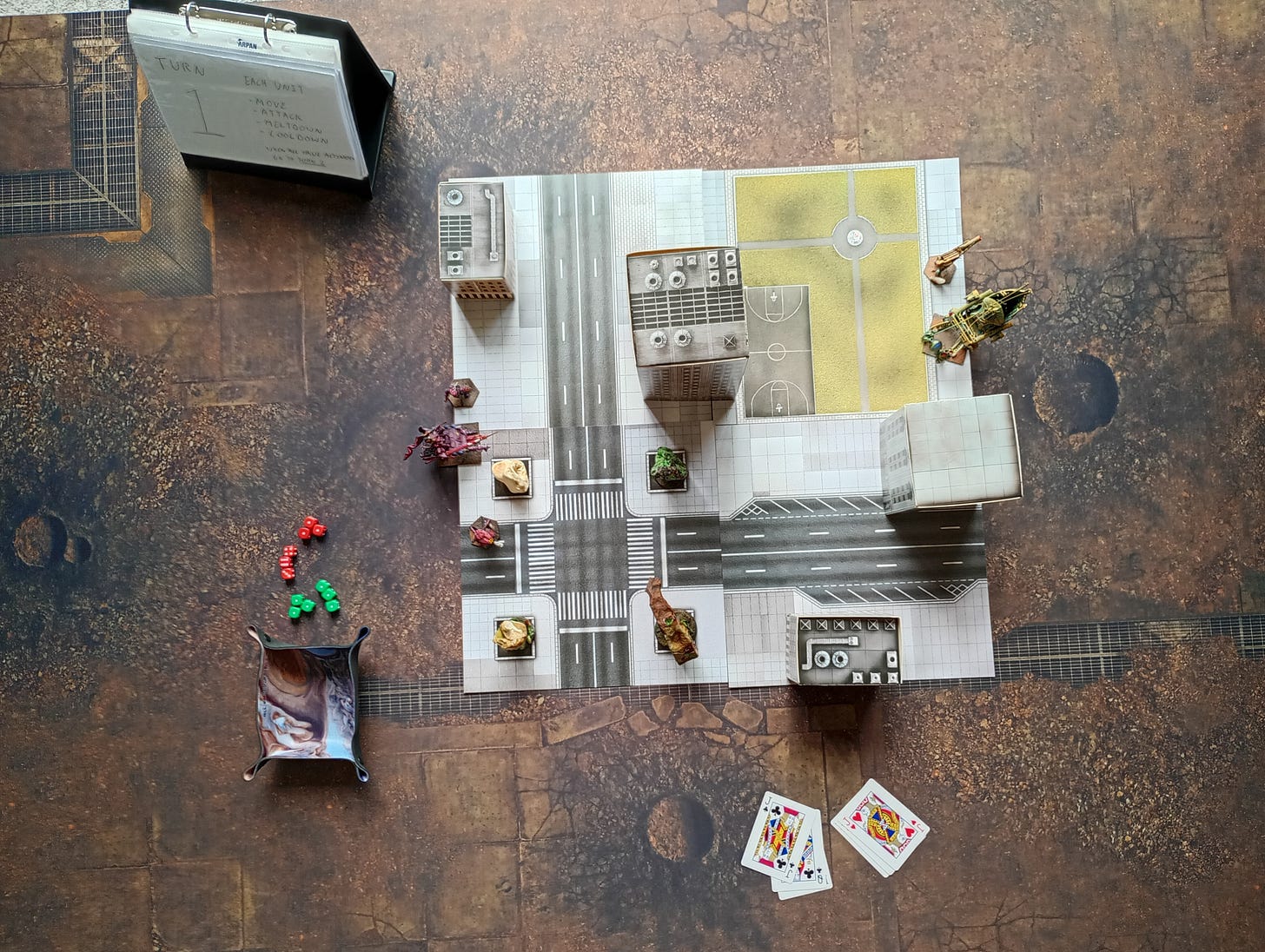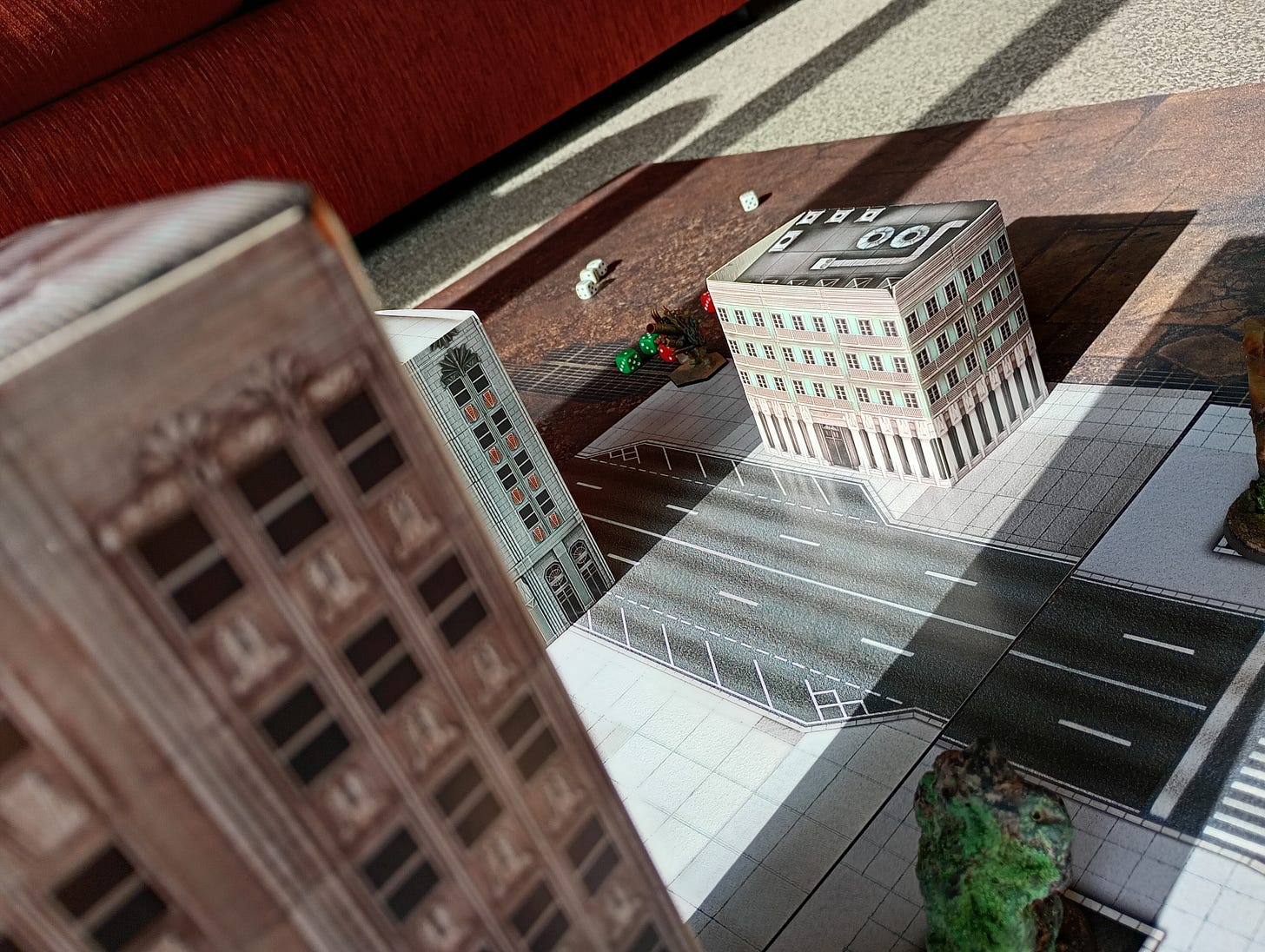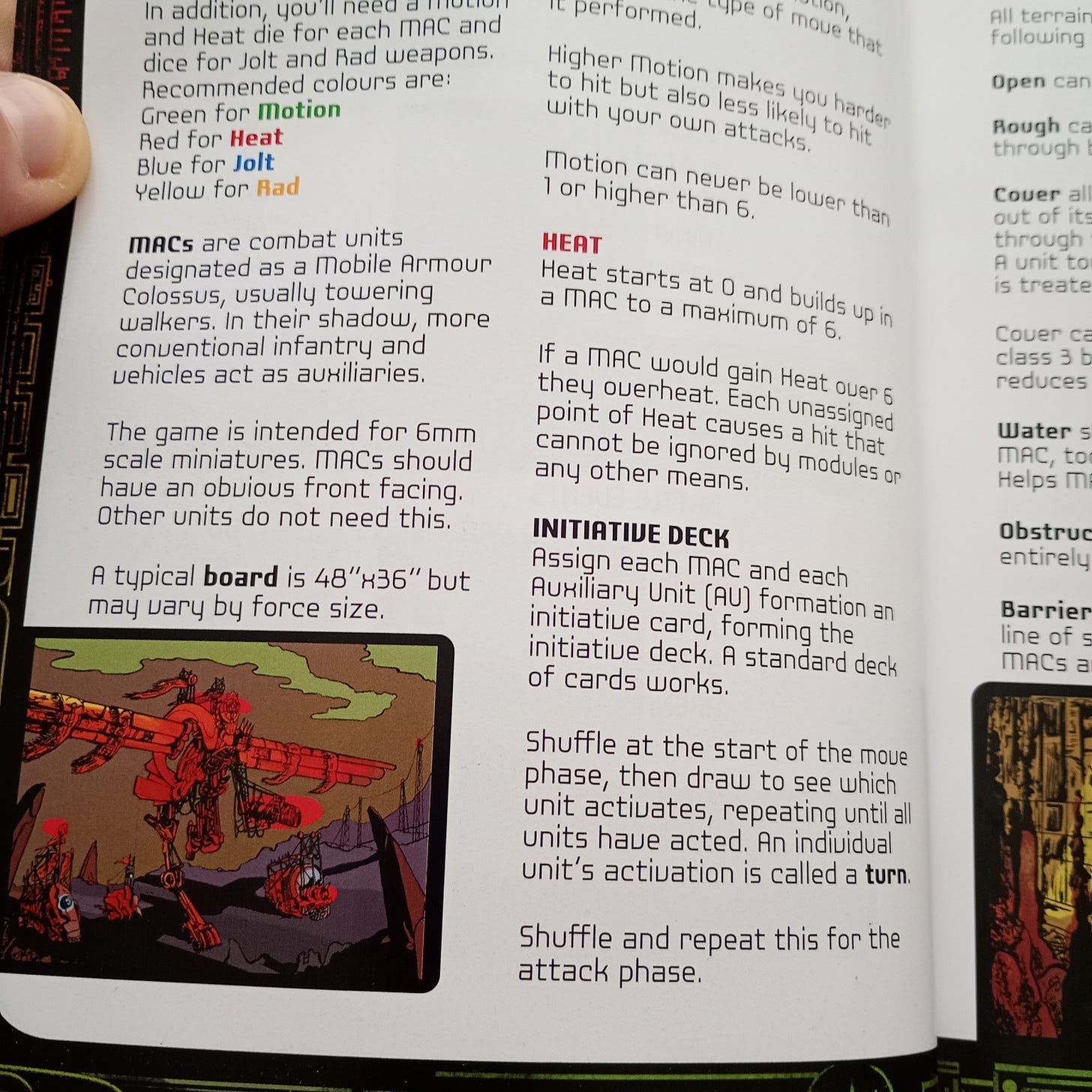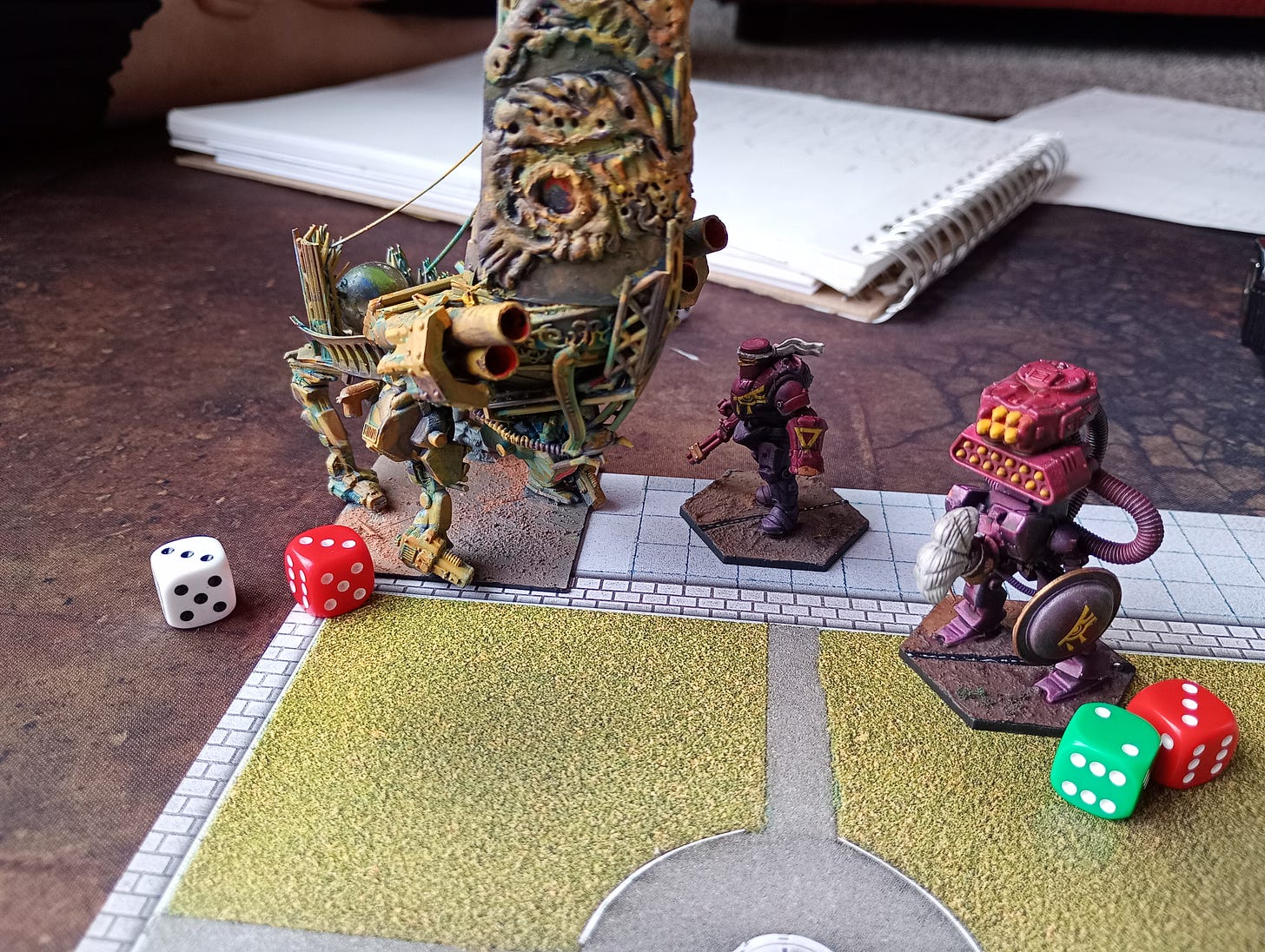MAC ATTACK 3 - The Dowlain Equations
he named the game after HIMSELF!! HE IS THE MAC WHICH WILL ATTACK!
the rules the rules the rules
This is the fourth part of my review of Chris McDowalls MAC ATTACK. Probably the most critical part!
Oblique MAC - The Crimes Of Page 6
Chris writes rules like equations, cleaving words and meanings down to their core, building the greatest possible depth in play, via the most minimal arrangement of interacting rules and then expressing those rules in the most minimal way.
(This also applies to, and interacts with, his principals of world creation; likewise inferring the maximum substance through the minimal suggestion.)
Nothing is said twice and nothing is clarified. 'To clarify' means; go back and read the rules again.
This makes them harder to learn than they might be if written in a slightly more maximalist style. It also means rules can end up slightly smeared across the book; a rule will be brought up sequentially in the text at the first reasonable opportunity and then never directly stated again.
It’s weird to me that almost all the instances of this I can think of relate to Page 6, which has a bunch of rules on it that sort-of relate to other apsects and systems of the game. I dunno I feel like Page Six is maybe an undercover page from a rival ruleset there to fuck things up.
Board Size;
A typical board is 38 inches by 46 inches and this is mentioned on the 'Getting Started' spread, and never again. The 'Battlefield' section describes terrain types and is on the opposite page of that spread, so it can be forgiven that the information isn't there, later on 'Scenario Generation' gets into other aspects of arranging the board, and the info isn't there either.
Initiative System;
The same page is responsible for our initial fuckup in which we (I) completely misread the MAC ATTACK initiative system because I missed or forgot one line from the bottom of Page 6; "Shuffle and repeat this for the attack phase."
I assumed you dealt the initiative cards, then simply ran each MAC in sequence of that initiative, completing each cycle of Move Phase, Attack Phase, Meltdown Phase, Cooldown Phase, for each one, before moving onto the next
This produced one bonkers rules artefact - machines did not have enough Motion. A core game concept is that your MAC sets is motion in the Move Phase and then fires at or punches another MAC, with its own motion score, the Target Number being the combination of both.
Running it the way I was, you strip Motion Die in the Cooldown phase, making much of that system inactive.
I am not that smart but I am not that dumb either and I am not the only person to have made this mistake.
Damage Splurge;
Rules on damage are splurged all over the book.
Damage from Heat is in 'Getting Started' (Page 6 again), Target Numbers and modifiers for crashed and cover are in the'Attack Phase'under 'The Round', Rules for taking damage from hit and how to roll a Systems Check are under 'MACS'.
Holy shit this book could do with a single damage page.
The above is really my main complaint about MAC ATTACK, which is less to do with how the rules actually work in-play, especially once they are absorbed by practice, and more to do with the style of their communication, where text minimalism and design and layout simplicity interact to produce something more oblique than it probably intended to be.
Micro MAC – Dowlain Minimalism
bear in mind, I don't think Chris has ever sold MAC ATTACK or any other ruleset as 'Minimal', so this is not a 'gotcha' analysis, but generally I think his rules 'seem' much more minimal on the page than they are in action.
True there are a highly limited number of concepts communicated through the minimal necessary words but as MAC ATTACK unpacks in play, the level of complexity rises.
At least while learning the game you are continually running through the Dowlian equations in your head, performing 'if-then' 'and-then' functions in your mind, working out exactly and precisely what the ruleset implies should be happening.
The amount of 'table furniture' doesn't seem that much less than other, much more complex games. Your MACs are followed through the game by two inevitable die, one showing HEAT the other MOTION, as well as occasional variated special-coloured die for some special weapon effects, plus your 'normal' attack die, wherever those are, plus your imitative card pile, plus discards from that
tape measure, and of course your carefully maintained MAC sheets with all your components and stuff detailed, continually being marked and amended as you fight - this you absolutely must have. It’s not 'tokened to fuck’ but it’s not 'light' either.
Elegant MAC - Self-Limiting Design
Chris sure does like his elegant rules concepts. I'm slightly surprised MAC ATTACK even has 'points' for force creation. Probably he is working on something simpler and self-limiting.
Heat Economy;
MACs only really suffer two main negatives; Heat, which builds up from fast movement, weapon firing and various other things, and which can turn into 'Damage' if it goes over 6, and 'Damage' itself.
Sure you can load your MAC up with guns and fire them every turn, but then it can barely move and will be spending most of its time sitting in a pond trying to cool down (Heat economy kicks in).
You can add radiators or coolant to your MAC, but thats space you cant then put a weapon,armour or any other special gizmo.
'Heat' gives MACs their own inherent economy of movement and attack. Big MACS can drain more Heat at the end of the round but that won't stop them gaining it in the first place and the Heat limit is always 6, which shifts the advantage back slightly towards small fast-moving MACs. These can hop about shooting quite a bit before they heat up too much, it gives them a strong identity-through-use or wieldself.
Activation and Risk;
MACs activate in a random initiative for movement, and then activate randomly again for the Attack phase. This adds its own spice to placement. Do you want to put your MAC in the best possible position to inflict the greatest possible damage? In that case it is almost certainly going to be in a vulnerable position for being shot or punched itself.
This economy of risk is flattened somewhat by MACs not functionally 'dying' being removed from the board, until the last part of the turn. However, they take damage, which means losing onboard components, immediately, with each attack. Getting to the end of the turn with your dick shot off doesn't feel like a reward.
The limits of MAC Power;
there are only three 'levels' of MAC. Power 1, Power 2 and Power 3, and every MAC has six only, and six total, modules, which account for its weapons and anything else it wants to bring.
The six-possible-things also relate to the D6 you roll when taking damage to your MAC - damage will take out these specific components, limiting your play in these specific ways.
The Movement Economy;
The same is true for movement and shooting - each type of motion carries a motion score - this can range from one to six. The 'to hit' roll baseline is the combined motion scores of both the shooter and the target.
Two slow-moving MACs with full line of sight can shoot each other pretty well - a fast-moving MAC has an intermediate chance to hit a slow one, and a slow one the same chance to hit a fast one - two fast MACs are going to have a very hard time hitting each other
(Plus by racing around you are building HEAT).
The relation of not just the enemies movement to the accuracy of shooting, but your own, means, depending on what you want your MAC to do, you may be carefully rationing your own movement, or trying to maximise it, even leaping and racing around when you don't really need to, if it will get you those vital extra 'Target Number' points in the Attack phase.
Again this seems to me like it would lead to a world of bif fat MACS being quite slow moving ranged weapons platforms and smaller MACS being quite 'hoppy' and Assault oriented.
Hard Choice Weapons Doctrine;
There are only three ranges. 'Short' means you simply *cannot* shoot at long range, 'Long' means you can't shoot at short range, but can hit the rest of the board, and 'Arc', which means you can shoot indirectly, long range only, but only if your allies are close to the target and in line of sight.
Boiling down all possible description and discussion of weapon ranges to the two most interesting (plus one more), and having these be mutually opposed - its one or the other and you have to choose, is a very Dowlian move and honestly a strong, bold and effective game design choice. Chris has got his dick out with this one. Do you really want to fuck about with an inch here or there and pseudo-natural weapons ranges, or do you want to make the strongest possible choices at MAC creation and then make that work with your tactics?
By taking away the fudgy 'intermediate' choices, Chris forces your MAC creation and Force Creation to adopt strong and distinctive playstyles. You can make MACs that cover both ranges, which limits what else they can do, make a whole force that can deal with mixed ranges between its MACS, or just go all-in on one particular concept and replicate that across the whole of the force. But you do have to choose and that choice will be limited and therefore interesting.
Big MAC - Selling the Burger
Chris boils down and boils down, interlinks and minimises, which is a large part of his intellectual work - literally what you are paying him for. But then he has to make a book out of the thing and sell the book, because that's the only way you can get rich making game rules. A dark truth of most Dowlian Rulesets is you could get them on two sides of A4. With what then, is the book to be filled?
Art, mainly. Visual design, and an absolute plethora of 'ways to play.
(I suppose he could just add all his design notes, all his records of test games, initial rules concepts, all the ways they were tested, enacted and reduced, a kind of answer to an exam question in which he 'shows his working', proving to the consumer that they are not just paying for aether, but for pure phlogiston.)
I feel Dowlianism might end up being emotionally incomprehensible to Americans. With Dowlian rules the methods and manners of play are implied, necessary unpacking’s of the minimal rules - you really can't play any way other than Chris's desired manner - he never actually tells you; this is the desired and inevitable method of play, either you work it out directly from the rules or you realise it during play. And with Dowlian books you are paying for what seems like less. Less text, less explanations, less apparent stuff.
Hard MAC – tell me twice treat me like an idiot
Maybe I do actually want to be told things twice, or at least for them to have section headings and bolding etc. The rules concepts have been boiled down to their textual PITH, saying absolutely no more than they utterly must. Everything is arranged in conceptually clear two-column prose.
I confess though, that I would have quite liked a touch more American ticker-tape. Maybe some flow-charts? or some stepped sub-headings? A bit more waste of space for a first read-through, but easier to parse. (How much a ruleset should or can be designed to read easily the first time, clearly the many times after, and/or occupy page space, is a throbbing design question no doubt, we need to get twirling our pubes about this, discuss it while walking the Acropolis, a slave will take notes on wax tablet.)
I know there is an 'how to play' Youtube thing, but I don't count the extra digital materials as part of the core design, (you can argue about this amongst yourselves in the comments)
A final complaint is that MAC ATTACK should probably have a hardcover and a stitched spine. This is a rules book that will be flipped through and consulted endlessly. Glued spines, no matter how good, get FUCKED UP by very regular use, which this will absolutely have - you will be SPERADING its pages a lot flat on the table, and the same is true of covers - as you will be THRUSTING this in and out of your bag continually as you read and re-read.









Sounds like this (and all rule books) should have wire comb or coil binding so you can lay them flat either as a spread or with one page face up. That’s how I get my PDFs printed at the stationery store and it is marvellous (plastic see through on the front cover, of course!)
Bro all the heavy innuendo in this one… what’s going on over there Patrick?? You alright mate? Mechs—I mean, er, MACS—getting you hot and bothered?
As an American I feel like I caught some flak here (SB2 BackhandedStereotype), but eh, probably deserved. I honestly liked the tight, terse rules delivery (though I agree there was more page flipping than needed, exacerbated by me printing out the quickstart and just having a big pile of paper), because it got my mind racing about what the implied synergies were.
My friend put some jets, a guided weapon, and a gyro on their MAC in our first game and got excited about the result: he could move fast into a good line of sight, set his motion to 1 right after, then hit whatever he wanted on a 2+ using his own motion for guided. Little discoveries like that made us want to tweak our lists and play again immediately after, which I guess is the highest possible praise for wargaming rules.
I had a lot of fun trying to build a force around having a big Class 3 with the hardest possible hitting Arc weapons and a cloak, then a bunch of super fast Class 1’s designed to fly into the enemy’s face and make them stay still to get hammered by the Class 3 from behind cover. The book did not tell me “this is a possible playstyle”, but I inferred it from reading the Arc weapon description and thinking oh that’s cool, how could I get the most out of that? Personally that made it more satisfying, even if I wasn’t actually coming up with something the designer hadn’t already thought of.